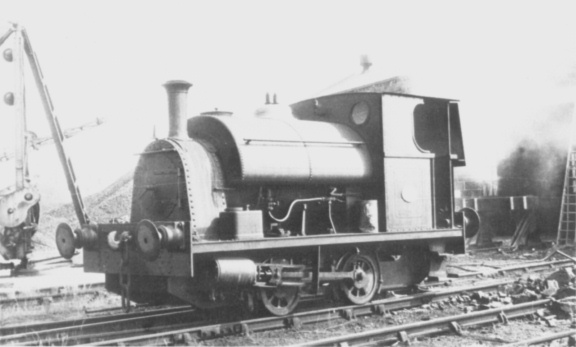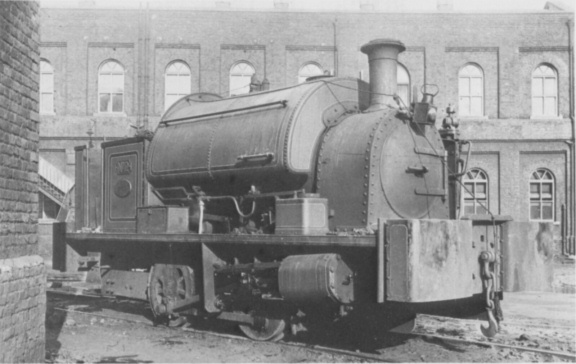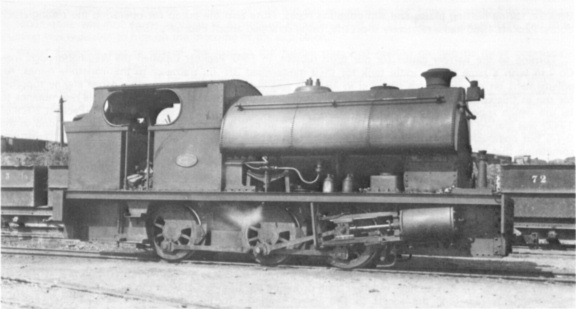
| THE INDUSTRIAL RAILWAY RECORD |
© APRIL 1974 |
UNUSUAL PECKETTS
ROGER E. WEST
Amongst the dozen more prominent builders of industrial locomotives in Britain it can probably be fairly claimed that Peckett strayed least from the orthodox, failing to indulge in articulated or geared creations. It becomes a rather difficult task therefore to consider contenders to be described under the above heading and one finds in many cases that a candidate is a superficial adaptation of a standard design rather than a deviant from the traditional mechanical norm. The following examples are locomotives of relatively normal outline but differing from their maker's usual product in some way.

Peckett 1682 at Oxford on 14th June 1958. She lasted until 1960, being scrapped sometime after August (R.E. West)
Peckett 1682 was a new design delivered to the Oxford & District Gas Company in 1925. Designated Class 1682, it had 9in by 14in cylinders and presumably was quite sufficient in power for the limited yard shunting requirements at the gas works. (The Bagnall locomotive used in the high level retort house was considerably smaller and largely constructed from narrow gauge components.) With the saddle tank stopping short of the smokebox, 1682 displayed a feature which probably more than any other altered her visual appearance from the pattern normally expected of Pecketts. She appears to have remained unique although further locomotives - for 3ft gauge and looking quite different - were classified 1682 and despatched to Singapore. (One of these was illustrated on page 90 of RECORD 37.)

Peckett 1966 at Beckton on 9th March 1947. Note the reduced ("flattened") side to the cylinders. (G. Alliez, courtesy B.D. Stoyel)
For its third generation of locomotives the Beckton Works of the Gas, Light & Coke Company turned to a variety of makers. In 1939 Peckett supplied their No.1966, classified Special R2 and of course based on the medium powered 12in four coupled saddle tank. Titled No.2 at Beckton, the loco appeared very different from the standard design although in fact the alterations were largely superficial - the short saddle tank again, the open cab and the narrowness of width. Other points are the lower steam dome with the safety valves and whistle mounted flush with the saddle tank top, the short chimney and the large Beckton spring buffing plates and slip coupling ropes. Note also the pump for operating the rolling stock doors. Peckett 1966 had a relatively short life, being scrapped about February 1957.

Peckett 2029 at Wellingborough on 31st August 1947. (G. Alliez, courtesy B.D. Stoyel)
Turning to the narrow gauge for our third subject, in 1942 Peckett supplied the Wellingborough Iron Co Ltd with a large 0‑6‑0 saddle tank for their modernised 3ft 3in tramway to the ironstone mines. An enlargement on previous locos supplied in 1934, it was the last really large narrow gauge engine supplied for use in this country. It was not a particularly handsome machine and certainly bore little resemblance to its sire which appears, oddly enough, to have been the four coupled R4 class, as the loco (Peckett 2029 of 1942) was classed Special R4. The boiler and 12in x 20in cylinders of No.2029 certainly correspond to the 0‑4‑0 but obviously frames and superstructure were completely new rethinking and the overall result was something that appeared but once from the Bristol works. The engine was withdrawn from service when the mines closed in 1966 but still exists, standing in a contractor's yard at nearby Finedon.

Official photograph of Peckett 753. (IRS Collection, courtesy F. Jones)
Lastly, Peckett 753 was constructed in 1898 for the Westbury Iron Co Ltd, Wiltshire, for use on their 2ft 0in gauge lines. Classed "Westbury", the locomotive appears to have been named COSSINGTON by its owners and numbered 3, joining two Hudswell Clarke & Rodgers 0‑6‑0 saddle tanks. The cylinder dimensions were 7in by 12in. An un‑Peckett like feature appears in what seems to be a raised firebox and, having noted the short saddle tank again, other features worthy of mention are the semi-circular shaped (on plan) coal bunker and the arch shaped weatherboard. The latter, having supported the pressure gauge, seems to do little beyond waste the material used in forming the two spectacle glasses. A rather long rear wheelbase for narrow gauge appears to have resulted from dropping the firebox between the axles. No doubt the crew had comments regarding the access to and egress from the footplate, seemingly dropped between the frames, with the rear springs as particularly effective shin barkers! The locomotive was sold by auction in February 1939 and was most likely cut up at once, though its exact fate is not known.